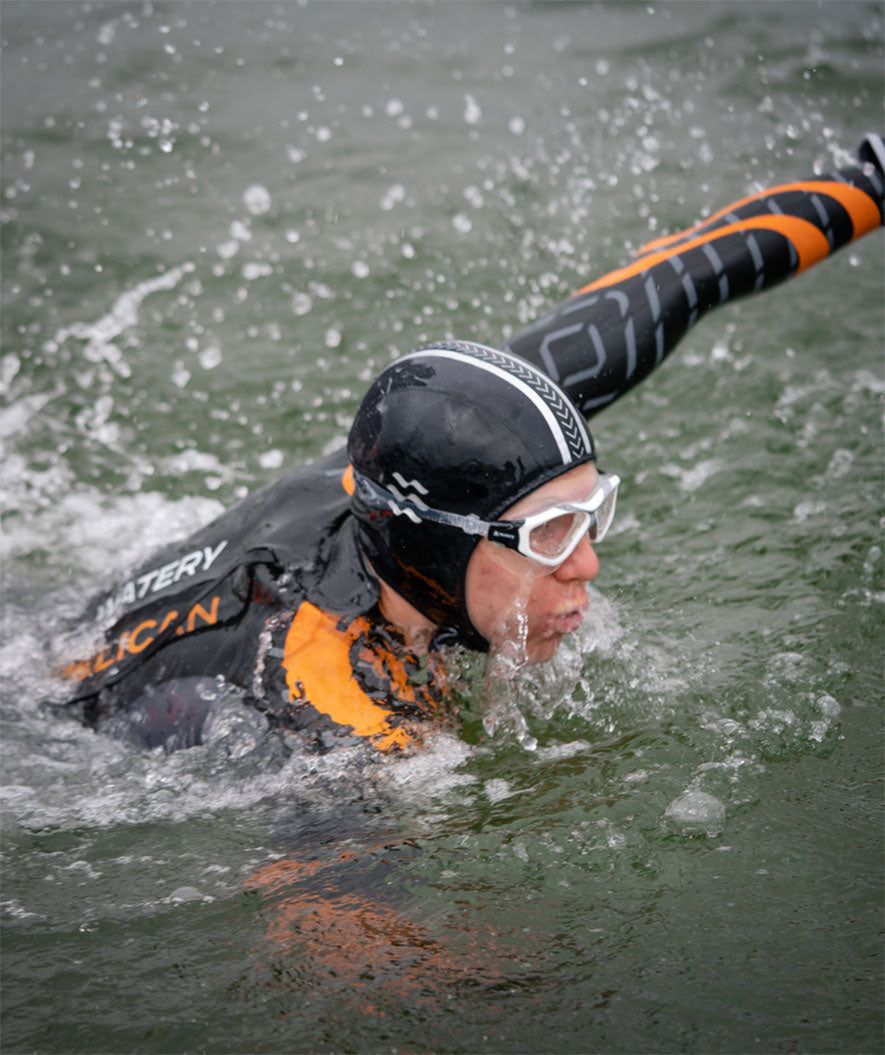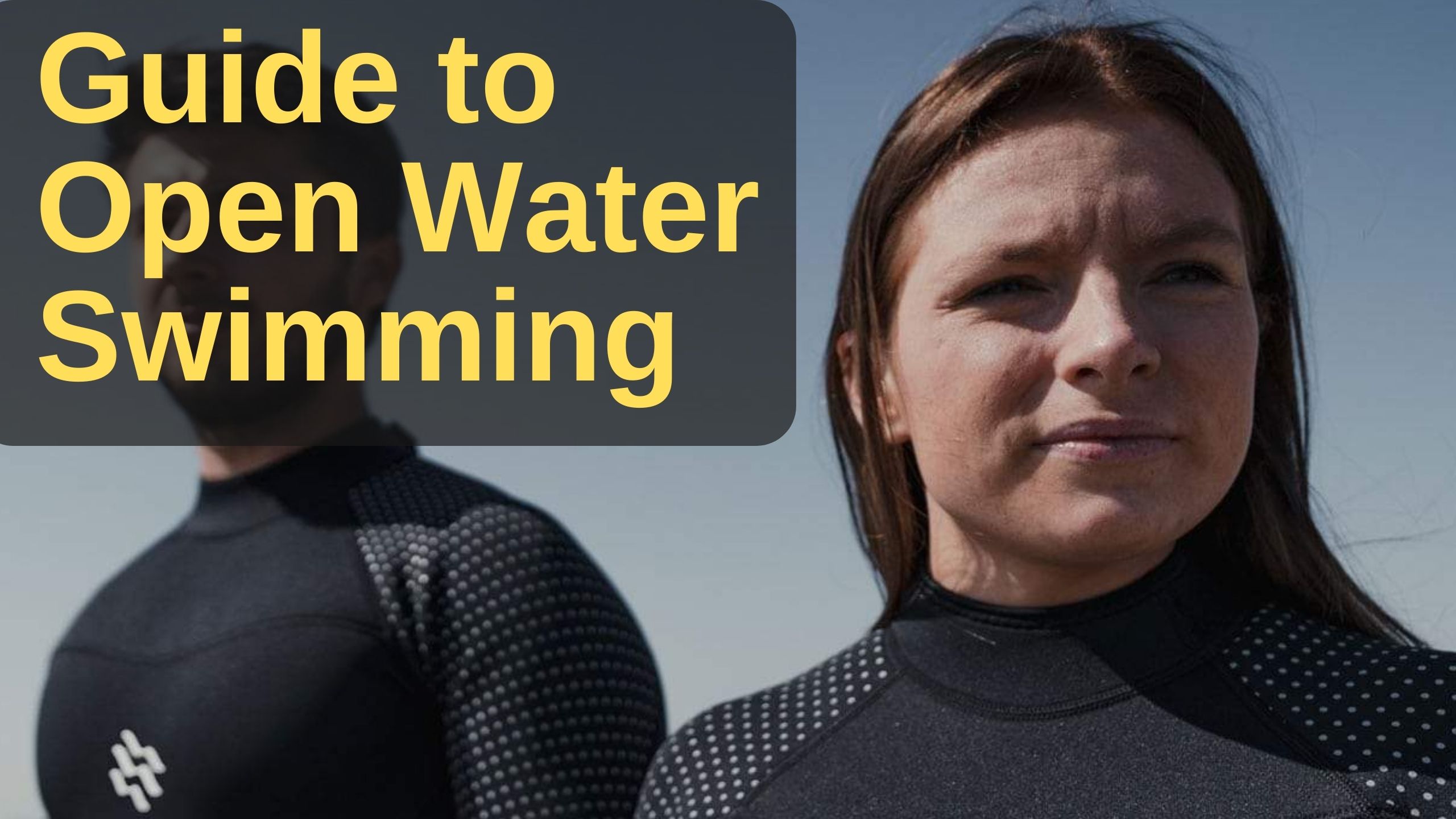In this article, you’ll find all the information you need to start with open-water swimming. There’s a lot of different guides out there, so I’ve focused on the basics and the essentials. Open-water swimming is a science in itself, with no rights or wrongs (almost).
The Gear You Will Need:
- Wetsuits
- Swim goggles
- Swim caps
- Buoys / Swim bags
- Water and Energy-gels.
A Cautionary Tale – From a Newbie
I’ve been working in the swimming industry for quite some time now. That also means that I’ve heard my fair share of funny and dangerous open-water swim stories. I had a friend who was just getting started in open-water swimming. Not a particularly skilled swimmer, but he wasn’t a beginner either. He was what I would call a hobby swimmer.
The Start
He decided that he would start in open-water swimming. I told him exactly what I’m telling you in this article: to do some research, make sure that the technique is on point, know the lake/sea beforehand, and make sure that the equipment is flawless, and make sure that you have all the necessities. His response was something like: “yeah, I’ve got it under control”. Since he was my friend, I believed him and let him on his way.
First Try at Open Water Swimming
The day came when he was going to try his first-ever open-water swim. He sent me a picture of his gear, and I wished him good luck. Where I live, we have beaches, seas and lakes basically everywhere, we live in the same city – so I knew where he was.
An hour later I decided to go check on him, so I went to the beach where I knew he was, and I saw him in the water. No problems at that time, he was just swimming and having a good time a bit offshore.
Cold and Shaking
Sometime later, I can’t remember how long time had passed, he returned to the beach. He was cold and shaking – like a lot. I asked him if he was okay because he looked pretty bad. He mumbled something like: “I’m freezing, and I’m feeling dizzy”.
I laid him down on the sand and got his wetsuit off. I could feel at the exact moment that I touched him, that he was wearing a cheap wetsuit. To be honest, I’m not even sure that it was made of neoprene, but the point is – I could understand why he was freezing.
I wrapped him in the two towels he brought, and he soon started to feel warmer. I asked him if he remembered to drink while he was in the water – he told me that his buoy broke on the way to the beach, and he couldn’t carry his flask.
He Survived
I knew there was some sort of dehydration going on, and I quickly got him some water. He started to feel better, luckily, and I told him that it was the last time he went swimming without proper equipment.
Your safety should be your top priority
When you are swimming in open water, there are some safety concerns that you need to be aware of.
- Make sure that you know yourself.
- Know your skill level.
- If you are new to swimming in general, then you need to make sure that you are up-to-date on all things swimming-related.
- Both in terms of swimming technique, and of course in the area you are planning to swim in.
There’s a major difference between pool swimming and open-water swimming. The water itself is way harsher, and unforgiving, meaning that you need to take proper precautions.
All in all, you need to make sure that you can swim, and that you have an idea of what you are doing.
6 Reminders While Open Water Swimming:
- Visibility, meaning that other people, boats etc. are able to spot you in the water. A dark wetsuit makes you extremely difficult to spot in open-water, and therefore some kind of buoy is an essential for you.
- Hydration, meaning that even though you are swimming in water – you won’t be able to stay hydrated like a person training in a fitness-center as an example. That means that you are exposed to the chance of dehydration. Dehydration + open water = bad day.
- Safe place for your belongings, meaning that if you are swimming alone you’ll need a place to store your valuables.
- Warmth, meaning that open-water is a cold experience if you aren’t prepared for it. A wetsuit is a must in 99% of the lakes or seas you’ll be swimming in.
- Buoyancy, both in terms of visibility and of course as an assist for you. Wetsuits provide more than one extra layer of protection – they are amazing for keeping warm, and to help you stay afloat.
- Anti-chafe measurements, getting in a neoprene wetsuit can be a painful experience. You can get some nasty blisters and rashes – which means that you need to make sure that you have some kind of lubricant to help you get in your wetsuit.
Essential Equipment for Open-water Swimming
Open-water swimming in itself can be difficult to navigate. There’s a lot of different opinions on how to swim in open water, and how to stay safe, etc.
My point here is that you should do your research beforehand.
Read a few guides and articles, make sure that you know what you are getting into. The key is to feel safe and to trust your own skill. If you are insecure about your skill, and whether or not your skill is high enough to swim in open water, then it’s better to take a few more sessions in a pool, just to make sure that your technique is on point.
Besides all the technical aspects of open-water swimming, there’s of course some gear-related stuff that you need to have before delving into open-water.

Provided by GetWatery
- Wetsuit
The wetsuit will be your absolute best friend, but if you aren’t careful it will also be your worst enemy. Make sure that the wetsuit you end up getting, suits the specific needs you have. Do you want a full-body suit, a suit with no arms and legs, or perhaps something entirely different. Also remember that you will have some buoyancy in the wetsuit, meaning that it will help you to stay afloat. Of course it won’t be able to carry the entirety of your body-weight. Make sure to get some lubricant as well, so you avoid chafes and other skin-rashes.

Provided by GetWatery
- Swim Goggles
You won’t be swimming in open-water without at least one pair of swim goggles. Since you are swimming in open water, you want goggles with polarized lenses, mirror-lenses and a large peripheral vision. If you are swimming on a day with lots of sunlight, you should also consider smoked lenses to make sure that you won’t be bothered by the sun. If you are swimming on days without sunlight, you could go for a pair of glasses without mirror, and just get polarized and clear lenses.

Provided by GetWatery
- Swimcap
In terms of a swim cap, there’s more than one use for them. Of course they give you some protection from the water, both in terms of damage to your hair – but also from the cold water. An important mention is that saltwater in large quantities is unhealthy for your hair. It can cause split ends, and completely dry it out. Make sure to wear a cap.

Provided by GetWatery

Provided by GetWatery
- Buoy / Swim-bag
Buoys serve a lot of different purposes. There’s buoyancy of course, storage, the opportunity to bring a water bottle, and your phone. A buoy drastically improves the visibility of you as well.
- Water and energy
Depending on which buoy you choose, you will have either a mesh-net on top, an accessible pocket or something completely different. The pros with these specific buoys is that you will be able to store water and energy-gel in them – and you will have full access to these. Water and energy-gel is extremely important for open-water swimmers. In some cases you have a long way back to the shore, which means that you need to make sure that you can stay hydrated and that your blood sugar won’t drop.
All of the above are just some of the most important essentials for a successful open-water swim. I’m 100% sure that you will be able to find different guides that say otherwise – which is also why I hope that you will do your best to research open-water swim before just jumping into it. Find out what suits your style best – and have an awesome time in the water!
Author:
Daniel Kristensen

